BIOSTRATINOMIC PROCESSES IN COASTAL SETTINGS
FLUVIAL-DELTAIC ENVIRONMENTS
Upper Delta Plain
LEVEES and CHANNEL MARGINS are sites that are biased towards the degradation of aerial plant parts (Scheihing
and Pfefferkorn, 1984 - Orinoco Delta, Venezuela ; Kosters and others, 1986 - Mississippi River Delta, Louisiana;
Gastaldo, 1986, 1989 - Mobile-Tensaw River Delta, Alabama ; Gastaldo and Huc, 1992 - Mahakam River Delta,
Kalimantan, Indonesia ; Gastaldo and Staub, 1996 - Rajang River Delta, Sarawak, East Malaysia).
- In tropical and temperate deltas examined, to date, roots and rootlets predominate recovered assemblages.
- Woody rootlets are more common in temperate climates, whereas cuticular sheaths of small rootlets dominate
tropical channel margins.
- More resistant aerial parts including bark, small branch fragments, wood, and seeds are infrequently
encountered.
- Leaves rarely are encountered whole or fragmented.
Upper delta ALLUVIAL PLAIN FORESTED SWAMPS are characteristic of both the temperate and tropical sites.
The density and diversity of plant communities in these regimes are different and reflected, in part, by their
taphoassemblages.
- Roots and rootlets are the principle plant part recovered from the subsurface mud.
- In the temperate swamps a low diversity forest dominated by Taxodium (Bald Cypress, a conifer) contributes
canopy detritus to the forest floor. This includes leafy shoots, trunks and branches, reproductive cones, and
seeds.
- Although leaf fragments may be difficult to assign to specific taxa, palynological and cuticular
preparations can provide the data to help assist in delimiting the ecology.
|
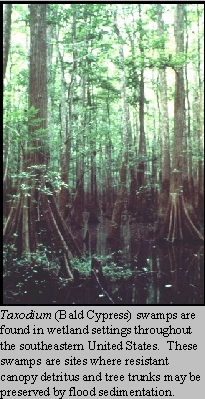 |
- The recovered assemblage in the interior of the swamp is monotypic, and litter horizons can be identified by
mud-cast prostrate logs (Gastaldo and others, 1989).
- Preservation of forest floor litters are due to major flood events in which overbank deposits bury litters. In tropical
swamp forests, additional components in the assemblage include woody canopy detritus and dicot angiosperm
leaves. Dispersed fragments of cuticle are frequently encountered.
Fluctuations in subsidence rates or breaching of the levee may result in the development of shallow lakes.
- Erect trees may remain intact within the lake, but macrodetrital contribution is principally from the aquatics and
semi-aquatics that inhabit the new environment.
- A small contribution from surrounding arborescent vegetation may occur.
Channel Systems
DISTRIBUTARY CHANNELS are the main conduits through which plant macrodetritus is moved into and through
the delta. Channel depths may exceed 30 m and it is difficult to recover channel bottom samples from these sites.
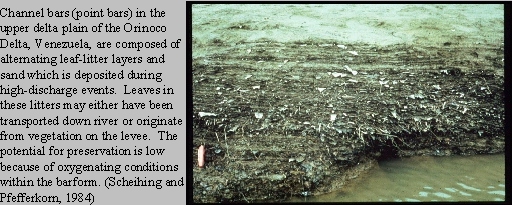
To date, information about plant part incorporation has been obtained from channel margins and subaqueous lateral
channel bars.
- Laminated leaf litter beds in the channel margin have been documented in the Orinoco Delta, but not found, to date,
in the other aforementioned deltas.
- These consist of transported branches and logs oriented parallel/subparallel to flow regime (although the
geomorphology of some channels precludes such concentrations)
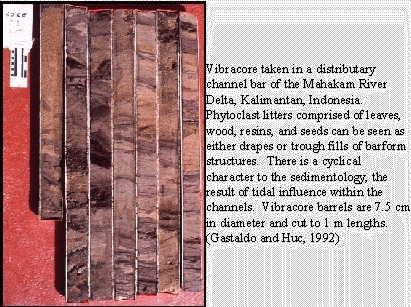
- Subaqueous lateral channel bars preserve plant detrital beds. These leaf-dominated litters may drape sand ripples,
occur within ripple and bedform troughs, and are usually interbedded with fine clastic sediment (silt and/or mud)
- These detrital beds commonly are comprised exclusively of dicotyledonous angiosperm remains.
- Wood clasts are generally flattened and rounded near their ends.
- A small component of allochthonous rootlets is sometimes encountered, originating from the erosion of
channel margin mud.
The ABANDONMENT of any channel provides a quiet water depositional site in which clastic influx may be cyclical
(tidal-influence) or intermittent (fluvial flooding). See:
Biostratinomic Processes in Lakes.
The TERMINUS of an active channel, either in the delta front or within an interdistributary bay, is a site where the
coarser load is deposited typically in MOUTH BARS.
- Fluctuating discharge velocities and interaction with marine processes (tides and/or waves) provide reduced flow
intervals when plant parts are deposited.
- Reworking of detritus occurs as bar sands are breached and themselves reworked. Most plant detritus is very
fragmentary, but comprised of leaf laminae and woody components.
- These parts are allochthonous, and have been transported to this depositional site from either upper delta
hardwood swamps or extrabasinal areas.
- Non-deciduous vegetation established in the lower delta plain contributes very little to these assemblages.
Lower Delta Plain
INTERDISTRIBUTARY BAYS develop between river channels as they prograde seaward. In fluvial-dominated deltas
these differ in mode of origin and sedimentological characteristics than those in tidally-influenced zones.
- Bioturbated mud preserve scattered and degraded phytoclasts is indicative of the temperate interdistributary bays.
- Larger woody detritus may be encountered infrequently within the subsurface, but it is not concentrated.
- Rootlets are a common component in shallow water sites where seasonal aquatic angiosperms are established.
Identifiable plant assemblages occur when a levee, surrounding the
interdistributary bay, has been breached and
CREVASSE SPLAY sediments accumulate.
- Bedded leaf litters are found throughout crevasse sediments and are more likely to preserve identifiable plant parts at
depths where anoxic conditions have developed (>15 cm).
- Taphoassemblages in all subaqueous and some subaerial sites are principally allochthonous in origin.
|
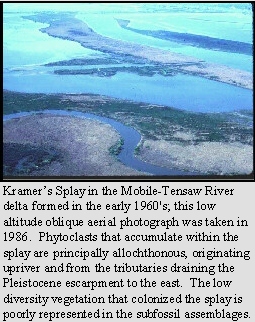
|
- The communities contributing most of the recovered plant parts are found either in the upper delta plain or
are extrabasinal in origin.
- ORGANIC-RICH SHOALS and BEACHES may form along the flanks of the crevasse shield in response to wave
and tidal processes active in the bay (see below).
Differences in Temperate Zones
The seasonality of temperate regions prohibits exclusively tropical vegetation from inhabiting low-lying coastal zone.
This is due to occasional freezing.
- Plant communities in temperate coastal zones are grass and sedge dominated with a small tree-shrub association
establishing on slightly better drained topographies.
- Rhizomatous mats are the conspicuous plant part preserved in the marshes, with occasional woody rootlets only in
the vicinity of established shrubs.
- The growth habit of the colonizers precludes the incorporation of most aerial parts into the subsurface.
- During the winter, grass stalks fall over and begin to decompose on or above the root mat.
- The contribution to the sediments is that of fixed carbon rather than identifiable macrodetritus. Seeds are
infrequently encountered, being dispersed distally by flood and tidal waters.
Differences in Tropical Zones
In contrast, lower delta plains in the tropics are dominated by monotypic or low diversity stands of palms and/or
mangrove taxa. Over 70% of the world's coastlines are vegetated by mangroves (salt-tolerant plants that include trees
[e.g., Rhizophora and Avicennia], palms [Nipa], and ferns [Acrostichum]).
|
In the Mahakam, monotypic swamps of Nipa fructicans
occur throughout the lower delta plain; There is a narrow seaward fringe
of mangrove trees. |
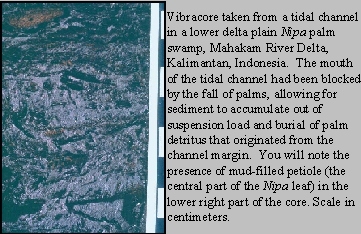 |
- Recovered taphoassemblages in Nipa swamps are dominated by rootlets, but woody rootlets are not encountered in
these sediments.
- Accessory aerial parts are almost restricted to sclerenchymatous exteriors of petioles.
- Few leafy laminae, fruits, and/or seeds have been recovered from the subsurface, although pollen is abundant.
In the Rajang, a peat-accumulating deltaic setting, the lower delta plain is vegetated by a dipterocarp-angiosperm
dominated forest, growing on an organic (peat) substrate. In general, mangroves fringe channel margins that are
influenced by tides, bringing brackish waters inland.
- Recovered assemblages in the dipterocarp swamps are organic-rich, with occasional bedded leaf mats, the result of
tree blowdown, excavation of the peat substrate, and the development of isolated acid-rich pools of groundwater
(Gastaldo and Staub, in press).
- Subsurface sediments of mangrove communities preserve woody root structures.
- Subsurface sediments rarely preserve canopy detritus, although pollen is abundant.
TIDAL FLATS are composed of fine-grained siliciclastics.
- Dispersed phytoclasts are incorporated into these sediments.
- Rarely are litter beds encountered.
- Where present they are composed of both upper delta plain or extrabasinal (from outside of the depositional
setting) dicotyledonous leaves, lower delta plain laminae, and resistant woody detritus.
Peat Beach - In areas away from active fluvial processes, phytoclasts
that had been transported to the delta front may be reworked
onto the tidal flats by wave action (Gastaldo and others, 1993). These accumulations may exceed 2 m in thickness,
forming BEACHES along the coast line.
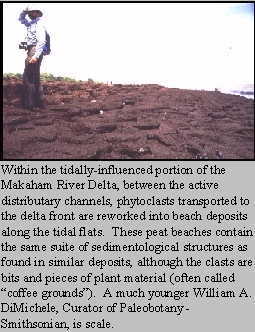
|
- Total Organic Carbon in these accumulations may reach 40%.
- The assemblage is comprised of dicotyledonous angiosperm leaf fragments, dispersed cuticles, resistant woody and
sclerenchymatous tissues, and damar (resins of Dipterocarpaceae).
- Although contributions from lower delta plain vegetation are found within the accumulation, they constitute a minor
part of the assemblage.
|
©Copyright 1997-1998 by Robert A. Gastaldo. All rights reserved. No
part of
these lecture notes may be reproduced or transmitted in any form or by any
means, electronic or mechanical, including photocopy, recording, or any
information storage and retrieval system, without permission from the
author.







